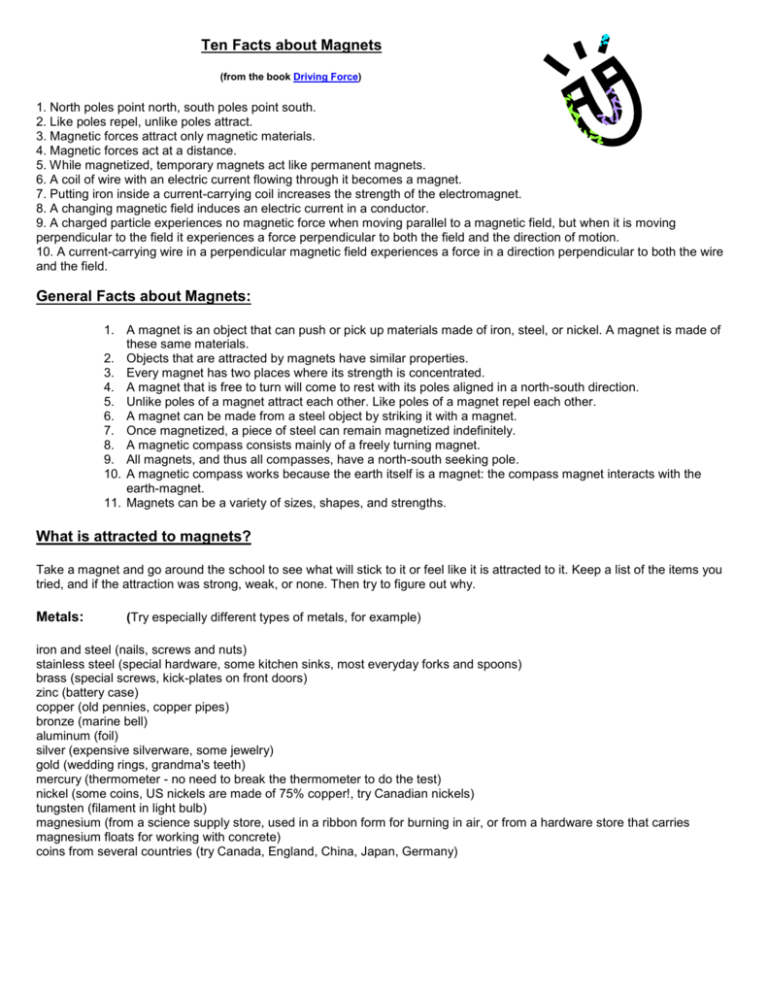Ten Facts about Magnets
advertisement

Ten Facts about Magnets (from the book Driving Force) 1. North poles point north, south poles point south. 2. Like poles repel, unlike poles attract. 3. Magnetic forces attract only magnetic materials. 4. Magnetic forces act at a distance. 5. While magnetized, temporary magnets act like permanent magnets. 6. A coil of wire with an electric current flowing through it becomes a magnet. 7. Putting iron inside a current-carrying coil increases the strength of the electromagnet. 8. A changing magnetic field induces an electric current in a conductor. 9. A charged particle experiences no magnetic force when moving parallel to a magnetic field, but when it is moving perpendicular to the field it experiences a force perpendicular to both the field and the direction of motion. 10. A current-carrying wire in a perpendicular magnetic field experiences a force in a direction perpendicular to both the wire and the field. General Facts about Magnets: 1. A magnet is an object that can push or pick up materials made of iron, steel, or nickel. A magnet is made of these same materials. 2. Objects that are attracted by magnets have similar properties. 3. Every magnet has two places where its strength is concentrated. 4. A magnet that is free to turn will come to rest with its poles aligned in a north-south direction. 5. Unlike poles of a magnet attract each other. Like poles of a magnet repel each other. 6. A magnet can be made from a steel object by striking it with a magnet. 7. Once magnetized, a piece of steel can remain magnetized indefinitely. 8. A magnetic compass consists mainly of a freely turning magnet. 9. All magnets, and thus all compasses, have a north-south seeking pole. 10. A magnetic compass works because the earth itself is a magnet: the compass magnet interacts with the earth-magnet. 11. Magnets can be a variety of sizes, shapes, and strengths. What is attracted to magnets? Take a magnet and go around the school to see what will stick to it or feel like it is attracted to it. Keep a list of the items you tried, and if the attraction was strong, weak, or none. Then try to figure out why. Metals: (Try especially different types of metals, for example) iron and steel (nails, screws and nuts) stainless steel (special hardware, some kitchen sinks, most everyday forks and spoons) brass (special screws, kick-plates on front doors) zinc (battery case) copper (old pennies, copper pipes) bronze (marine bell) aluminum (foil) silver (expensive silverware, some jewelry) gold (wedding rings, grandma's teeth) mercury (thermometer - no need to break the thermometer to do the test) nickel (some coins, US nickels are made of 75% copper!, try Canadian nickels) tungsten (filament in light bulb) magnesium (from a science supply store, used in a ribbon form for burning in air, or from a hardware store that carries magnesium floats for working with concrete) coins from several countries (try Canada, England, China, Japan, Germany) Activity: Objective: To investigate and understand that magnets can be a variety of sizes, shapes, and strengths. Materials: * bar magnets * circular magnets * horseshoe magnets * regular refrigerator magnet * paper clips * sheets of loose leaf paper * pieces of cloth pieces of wax paper pieces of aluminum foil pencil and paper to record data * * * Instructions: 1. Discuss the information (on previous pages) at the beginning of your discussion with your mentee. On the worksheet provided, predict how many paper clips each magnet will pick up. 2. After making his/her prediction, have your Mentee put their paper clips in a pile. One magnet at a time, hold the magnet over the pile of paper clips to see how many will be attracted. 3. Once the magnet has picked up the paper clips, move the magnet away from the pile and pull each paper clip off the magnet. Record the number of paper clips it lifted in the chart under the appropriate magnet. 4. Which magnet picked up the least amount of paper clips? Which magnet picked up the most paper clips? Which magnet is the strongest? Which magnet was the weakest? Was the biggest magnet the strongest? Does the size of a magnet affect the strength of a magnet? 5. Allow the Mentee to explore to discover through what materials their magnets will still pick up paper clips. Collect some of the materials in the list above and experiment with these. Record the number of paper clips the magnet picked up wrapped in the different materials. 6. Did the magnet still work through the various materials? Did the number of paper clips the magnet picked up change? If so, by how many for each material? Conclusion: the size of a magnet was not as much of a factor in determining its strength as was the size of the surface area of the ends of the magnet.







